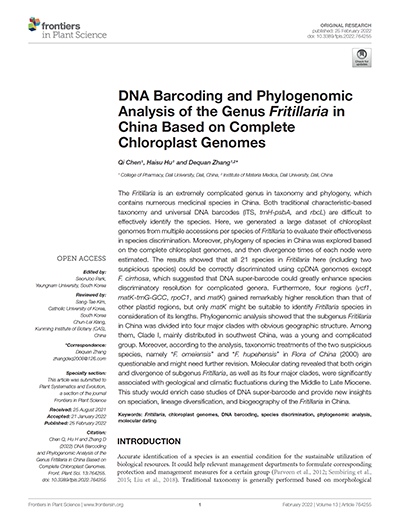NEWS 2022
DNA Barcoding and Phylogenomic Analysis of the Genus Fritillaria in China Based on Complete Chloroplast Genomes
Qi CHEN, Haisu HU, Dequan ZHANG
Frontiers in Plant Science 2022
https://doi.org/10.3389/fpls.2022.764255
College of Pharmacy, Dali University, Dali, China, 2 Institute of Materia Medica, Dali University, Dali, China
Abstract
The Fritillaria is an extremely complicated genus in taxonomy and phylogeny, which contains numerous medicinal species in China. Both traditional characteristic-based taxonomy and universal DNA barcodes (ITS, trnH-psbA, and rbcL) are difficult to effectively identify the species. Here, we generated a large dataset of chloroplast genomes from multiple accessions per species of Fritillaria to evaluate their effectiveness in species discrimination. Moreover, phylogeny of species in China was explored based on the complete chloroplast genomes, and then divergence times of each node were estimated. The results showed that all 21 species in Fritillaria here (including two suspicious species) could be correctly discriminated using cpDNA genomes except F. cirrhosa, which suggested that DNA super-barcode could greatly enhance species discriminatory resolution for complicated genera. Furthermore, four regions (ycf1, matK-trnG-GCC, rpoC1, and matK) gained remarkably higher resolution than that of other plastid regions, but only matK might be suitable to identify Fritillaria species in consideration of its lengths. Phylogenomic analysis showed that the subgenus Fritillaria in China was divided into four major clades with obvious geographic structure. Among them, Clade I, mainly distributed in southwest China, was a young and complicated group. Moreover, according to the analysis, taxonomic treatments of the two suspicious species, namely “F. omeiensis” and “F. hupehensis,” in Flora of China (2000) are questionable and might need further revision. Molecular dating revealed that both origin and divergence of subgenus Fritillaria, as well as its four major clades, were significantly associated with geological and climatic fluctuations during the Middle to Late Miocene. This study would enrich case studies of DNA super-barcode and provide new insights on speciation, lineage diversification, and biogeography of the Fritillaria in China.




